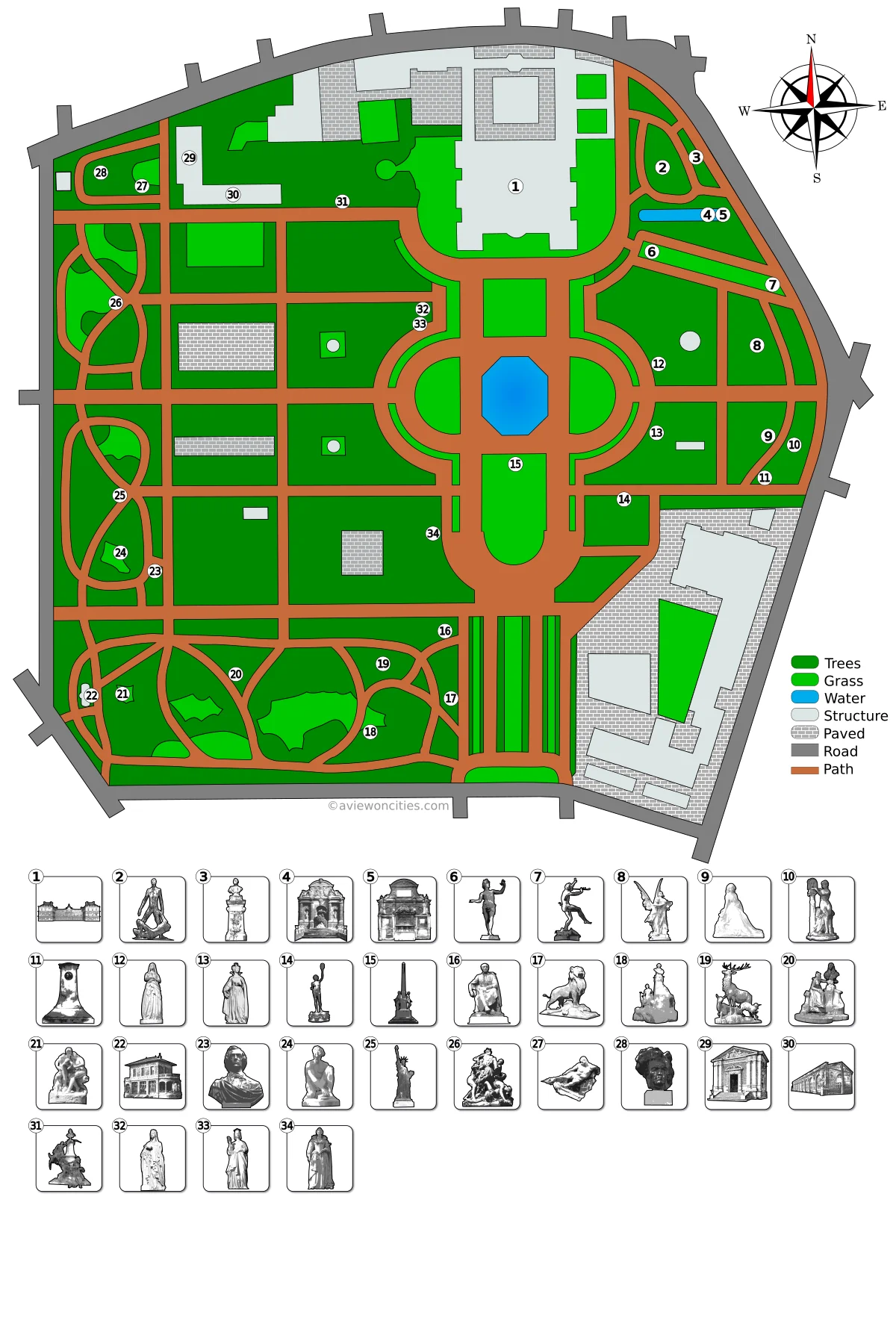The Jardin du Luxembourg is probably the most popular park in Paris. The park, situated near the Latin Quarter, offers a lot of variety and attracts all kinds of people, from students and parents with children to tourists.
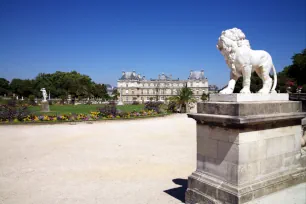
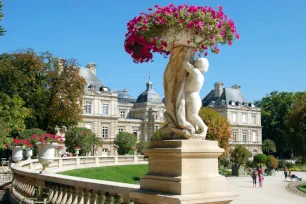
The 22.45-hectare-large park (about 55 acres) can get pretty crowded when the sun comes out. Students come here to rehearse their courses, neighbors come here for a stroll and like with all great places in Paris, there are always plenty of tourists. But despite its popularity, the Jardin du Luxembourg is plenty enjoyable and a welcome relief from the crowded Parisian streets.
History
The park was originally owned by the duke of Luxembourg, hence the name. The domain was purchased in 1612 by Marie de’ Medici, the widow of King Henry IV. After the king was murdered in 1610 she decided to move out from the Louvre to a new residence.
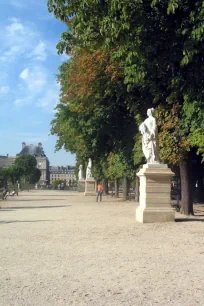
Marie de’ Medici was of Italian descent and had spent her youth in Florence at the Pitti Palace, so when she commissioned architect Salomon de Brosse with the construction of a new palace, she asked him to look at the Pitti Palace for inspiration.
The Italian-style Boboli garden at this palace was also the inspiration for the Jardin du Luxembourg, so it was originally laid out in the Italian style. At the time, the garden was quite small due to the existence of a Carthusian monastery to the south of the palace. Despite the insistence of Marie de’ Medici, the Carthusians refused to leave, and the garden stretched no further than the current octagonal pond.
Almost two hundred years later, during the French Revolution, the Carthusians were forced to leave when revolutionaries confiscated the monastery. This paved the way for a significant expansion of the gardens and a redesign in a more French style. Baron Haussmann, during his massive urban renewal of Paris in the mid-nineteenth century, nibbled at the edges of the park, but it is still one of the largest green spaces in the center of Paris.
Buildings
The Palace
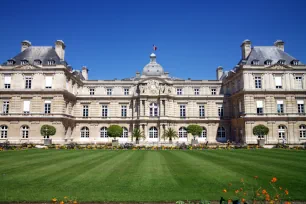
The Palais du Luxembourg ![]() (Luxembourg Palace) was constructed between 1615 and 1631 at the northern end of what would become the Jardin du Luxembourg.
(Luxembourg Palace) was constructed between 1615 and 1631 at the northern end of what would become the Jardin du Luxembourg.
The palace was built in a Florentine style that reminded Marie de’ Medici of the palace where she grew up. The widowed queen did not get the time to enjoy her new palace and gardens for long, as she was banished by Cardinal Richelieu in 1631, right before the palace was completed.
In 1794, during the French Revolution, the palace served as a prison. Five years later, at the end of the revolution, it was assigned to the French senate. The following century the palace was expanded and remodeled several times to accommodate the growing needs of the senate. After a hiatus as a result of the Prussian occupation of Paris during the Franco-Prussian War the senate returned in 1879, until the Second Word War, when it served as the headquarters of the Luftwaffe. The building currently houses the French Senate once again.
The museum
The Musée du Luxembourg ![]() was the first French museum to open to the public, in 1750, well before the Louvre, which only opened to the public more than 40 years later, in 1793. It was originally housed in the Luxembourg Palace. During the 19th century the museum displayed contemporary art from living artists only. In 1879 the French senate wanted more space and forced the museum out. Their new home – the present building – opened in 1886 as an extension to the orangery. The museum closed in 1937 when its collection moved to the Palais de Tokyo but reopened in 1979 as a museum for regional art. Today the museum is only open for temporary exhibitions.
was the first French museum to open to the public, in 1750, well before the Louvre, which only opened to the public more than 40 years later, in 1793. It was originally housed in the Luxembourg Palace. During the 19th century the museum displayed contemporary art from living artists only. In 1879 the French senate wanted more space and forced the museum out. Their new home – the present building – opened in 1886 as an extension to the orangery. The museum closed in 1937 when its collection moved to the Palais de Tokyo but reopened in 1979 as a museum for regional art. Today the museum is only open for temporary exhibitions.
The orangery
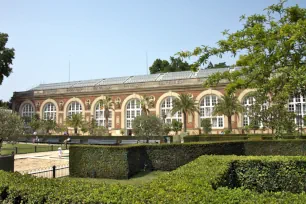
A first orangery ![]() – a building used to store outdoor plants during the winter – was created by Marie de’ Medici. The current orangery in the northwest corner of the Jardin du Luxembourg was built in 1839 by the French architect Alphonse de Gisors, who also created the long pond in front of the park’s best known fountain: the Medici Fountain. The facade of the building facing the park is adorned with busts of French artists.
– a building used to store outdoor plants during the winter – was created by Marie de’ Medici. The current orangery in the northwest corner of the Jardin du Luxembourg was built in 1839 by the French architect Alphonse de Gisors, who also created the long pond in front of the park’s best known fountain: the Medici Fountain. The facade of the building facing the park is adorned with busts of French artists.
The orangery houses about 180 plants during winter, while in the summer it is often used for art exhibitions hosted by the Musée du Luxembourg.
Davioud Pavilion
In 1867 an elegant pavilion ![]() was built in the southwest corner of the park which served as a café-restaurant. Today the Luxembourg school of horticulture uses the pavilion for free public courses, and it is also used for various art exhibitions. It is named after Gabriel Davioud, an architect who worked under Haussmann. He is best known for the theater buildings on the Place du Chatelet and for his many monumental fountains, such as the Saint-Michel Fountain.
was built in the southwest corner of the park which served as a café-restaurant. Today the Luxembourg school of horticulture uses the pavilion for free public courses, and it is also used for various art exhibitions. It is named after Gabriel Davioud, an architect who worked under Haussmann. He is best known for the theater buildings on the Place du Chatelet and for his many monumental fountains, such as the Saint-Michel Fountain.
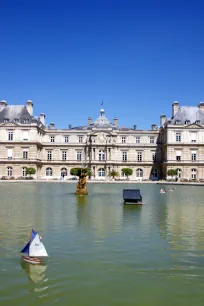
The Park
In the middle of the park is a large octagonal pond, known as the Grand Bassin. Here, children can rent small boats. The Jardin du Luxembourg boasts many other attractions for children such as a puppet theater, pony rides, a merry-go-round and a large playground.
Around the pond are nice lawns, paths, and some of Paris’s most beautiful flower beds, all laid out in a geometrical pattern and often enclosed by a balustrade. Numerous statues adorn the park. The park is also popular with chess players and jeu de boules players since there are large dedicated playing fields in the park. There’s even a tennis court and also a music pavilion.
The chairs
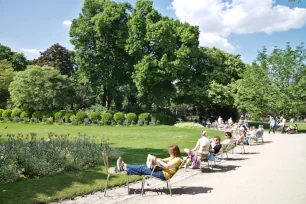
The Jardin du Luxembourg is known as one of the greatest parks in Paris, not just for its beautiful layout and abundance of statues, but also for its chairs: this is one of the parks where you can simply get hold of one of the many chairs and take it to the exact spot where you want to sit.
These chairs have been around since the eighteenth century, but they were originally owned by private companies and visitors could hire them for a price. It wasn’t until 1974 that the French senate decided to buy up all the chairs and make them free. The model of the chairs was standardized in 1955. They are rather heavy, which makes them not only sturdy, but it also acts as a theft deterrent.
Fountains
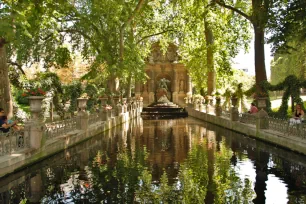
The Jardin du Luxembourg features several noteworthy fountains. The most famous one is the Fontaine Médicis ![]() , a romantic Baroque fountain designed in the early seventeenth century.
, a romantic Baroque fountain designed in the early seventeenth century.
It is located at the end of a small pond at the northeast side of the park. A central sculpture group shows the Greek mythological figure of Polyphemus, who observes the lovers Acis and Galatea. It is flanked by allegorical figures depicting the rivers Seine and Rhône.
Few people realize that there’s another fountain – the Fontaine de Léda ![]() – at the back of the Fontaine Médicis. A relief on the fountain, which dates from 1806, shows a mythical scene with Leda and Zeus disguised as a swan.
– at the back of the Fontaine Médicis. A relief on the fountain, which dates from 1806, shows a mythical scene with Leda and Zeus disguised as a swan.
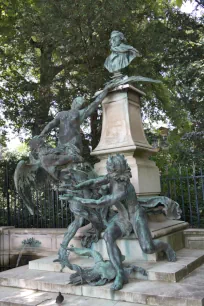
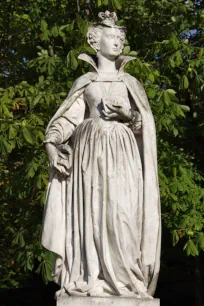
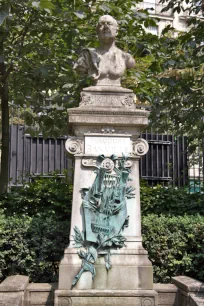
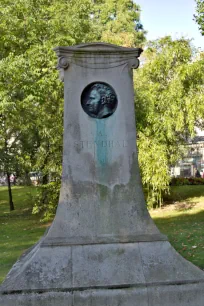
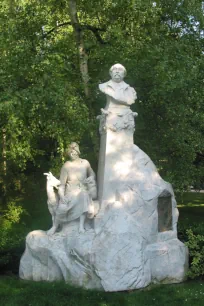
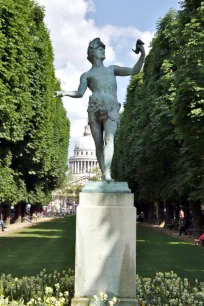
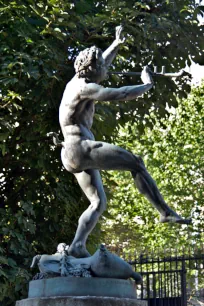
There’s a third fountain on the other, west side of the palace: the Fontaine Delacroix ![]() . It honors the French painter Eugène Delacroix and consists of a rectangular basin with six jets. At the center is a tall pedestal with a bust of the painter. Sensual allegorical statues of Time, Glory and Genius stretch from a plinth towards the bust.
. It honors the French painter Eugène Delacroix and consists of a rectangular basin with six jets. At the center is a tall pedestal with a bust of the painter. Sensual allegorical statues of Time, Glory and Genius stretch from a plinth towards the bust.
Statues – lots and lots of statues
French queens and illustrious women
There are around one hundred statues and monuments scattered around the park. A large number of these can be found around the central parterre in front of the palace. They are part of a series called “French queens and illustrious women”: twenty statues of French women – mostly queens, but also saints and celebrities – who made their mark on French history. They were selected by King Louis Philippe I, and were created by a number of different artists between 1843 and 1846, except for the statue of Marguerite d’Anjou. This statue was added in 1877 to replace a statue of Joan of Arc, which was moved to the Louvre in 1872 to protect it from the elements.
Naturally, one of the statues depicts Marie de’ Medici ![]() (1575-1642), queen of France from 1600 until 1614 and the original creator of the park. The stone sculpture was created in 1847 by Louis-Denis Caillouette. Other notable figures include Sainte-Geneviève
(1575-1642), queen of France from 1600 until 1614 and the original creator of the park. The stone sculpture was created in 1847 by Louis-Denis Caillouette. Other notable figures include Sainte-Geneviève ![]() (423-512), patroness of Paris; Anne of Brittany
(423-512), patroness of Paris; Anne of Brittany ![]() (1477-1514), queen of France from 1491 until 1498; Mary Stuart
(1477-1514), queen of France from 1491 until 1498; Mary Stuart ![]() (1542-1587), queen of France from 1559 until 1560, and Sainte Clotilde
(1542-1587), queen of France from 1559 until 1560, and Sainte Clotilde ![]() (465-545), the first Christian queen of France.
(465-545), the first Christian queen of France.
More French personalities
Many of the statues and monuments in the Jardin du Luxembourg honor famous (mostly French) people, from politicians and scientists over sculptors and painters to poets and composers.
Authors in particular are well represented with sixteen sculptures. The most impressive of these is the monument dedicated to Leconte de Lisle ![]() (1818-1894), a French poet who is traditionally known by his last name only. The monument shows a winged allegorical statue of Glory embracing a bust of the poet, who used to walk through the Jardin du Luxembourg on a daily basis. The marble monument was created in 1897 by the French sculptor Denys Puech and inaugurated here the following year.
(1818-1894), a French poet who is traditionally known by his last name only. The monument shows a winged allegorical statue of Glory embracing a bust of the poet, who used to walk through the Jardin du Luxembourg on a daily basis. The marble monument was created in 1897 by the French sculptor Denys Puech and inaugurated here the following year.
Not all poets received the honor of such a large monument: Théodore de Banville ![]() (1823-1891), another French poet, is remembered with a much smaller monument showing a bust created in 1892 by Jules Roulleau. The rather elaborate pedestal is adorned with a bronze lyre, the work of Henri-Léon Thiébaut.
(1823-1891), another French poet, is remembered with a much smaller monument showing a bust created in 1892 by Jules Roulleau. The rather elaborate pedestal is adorned with a bronze lyre, the work of Henri-Léon Thiébaut.
George Sand ![]() (1804-1876), one of France’s most famous female novelists, is also honored with a statue in the Jardin du Luxembourg. Despite her preference for wearing men’s clothes and smoking cigars, the French sculptor François Sicard decided to depict her as a very feminine woman dressed in a beautiful white gown. Sand long had a relationship with the famous composer Frédéric Chopin
(1804-1876), one of France’s most famous female novelists, is also honored with a statue in the Jardin du Luxembourg. Despite her preference for wearing men’s clothes and smoking cigars, the French sculptor François Sicard decided to depict her as a very feminine woman dressed in a beautiful white gown. Sand long had a relationship with the famous composer Frédéric Chopin ![]() (1810-1849), whose bronze bust can also be found in this park. It is a 1900 copy of a marble bust from 1872 by the Polish sculptor Bolesław Syrewicz.
(1810-1849), whose bronze bust can also be found in this park. It is a 1900 copy of a marble bust from 1872 by the Polish sculptor Bolesław Syrewicz.
Ludwig van Beethoven ![]() (1770-1827), another famous composer, is memorialized in the Jardin du Luxembourg with an expressive bust by the French sculptor Antoine Bourdelle, a student of the famous Auguste Rodin. The latter also made a contribution to the Jardin du Luxembourg: the medallion on a monument to Stendhal
(1770-1827), another famous composer, is memorialized in the Jardin du Luxembourg with an expressive bust by the French sculptor Antoine Bourdelle, a student of the famous Auguste Rodin. The latter also made a contribution to the Jardin du Luxembourg: the medallion on a monument to Stendhal ![]() (1783-1842) – a French novelist – is Rodin’s work. Bullet holes visible in the back of the base of the monument bear witness to the fighting during the liberation of Paris at the end of the Second World War.
(1783-1842) – a French novelist – is Rodin’s work. Bullet holes visible in the back of the base of the monument bear witness to the fighting during the liberation of Paris at the end of the Second World War.
Ferdinand Fabre ![]() (1827-1898), another French novelist whose novels depict the life of the peasants and clergy, is also honored with a monument in the park. It is the work of the French sculptor Laurent Marqueste, and shows a bust of the writer accompanied by a shepherdess and a goat. A similar monument is dedicated to the French Painter Jean-Antoine Watteau
(1827-1898), another French novelist whose novels depict the life of the peasants and clergy, is also honored with a monument in the park. It is the work of the French sculptor Laurent Marqueste, and shows a bust of the writer accompanied by a shepherdess and a goat. A similar monument is dedicated to the French Painter Jean-Antoine Watteau ![]() (1684-1721). It shows a pewter bust of the painter, alongside a marble statue of a young woman representing Youth, who places flowers at the foot of the bust. The monument was unveiled here in 1896 and is the work of Henri Gauquié.
(1684-1721). It shows a pewter bust of the painter, alongside a marble statue of a young woman representing Youth, who places flowers at the foot of the bust. The monument was unveiled here in 1896 and is the work of Henri Gauquié.
Not all personalities honored with statues are artists. A monument in the center of the park, near the octagonal basin, is dedicated to Scheurer-Kestner ![]() (1833-1899), a chemist and industrialist. The monument was created in 1908 by Jules Dalou and consists of a central obelisk flanked by allegorical statues of Justice and Truth. The engineer and sociologist Frédéric Le Play
(1833-1899), a chemist and industrialist. The monument was created in 1908 by Jules Dalou and consists of a central obelisk flanked by allegorical statues of Justice and Truth. The engineer and sociologist Frédéric Le Play ![]() (1806-1882) has a statue in his honor alongside the central corridor of the park. The statue, which shows him seated, dates from 1906 and was created by the French sculptor André Allar.
(1806-1882) has a statue in his honor alongside the central corridor of the park. The statue, which shows him seated, dates from 1906 and was created by the French sculptor André Allar.
Mythology & Antiquity
There are more than ten statues in the Jardin du Luxembourg that are either copies of antique statues or that were inspired by Antiquity. Many of them depict Roman goddesses such as Juno – protector of the state, Diana – the goddess of hunting – and there are even two statues of Flora – goddess of flowers – and also two of Venus – the Roman goddess of love and beauty. But the best known statue inspired by Antiquity is the statue of a Greek actor ![]() in the northeast corner of the park. The bronze statue dates from 1868 and is the work of Charles-Arthur Bourgeois.
in the northeast corner of the park. The bronze statue dates from 1868 and is the work of Charles-Arthur Bourgeois.
A narrow lawn separates this statue from another well-known bronze statue: the Dancing Faun ![]() , which was installed here in 1852. It is the principal work of the French sculptor Eugène-Louis Lequesne. It depicts a faun – a mythical creature that is part animal, part human – dancing and playing a flute.
, which was installed here in 1852. It is the principal work of the French sculptor Eugène-Louis Lequesne. It depicts a faun – a mythical creature that is part animal, part human – dancing and playing a flute.
Another statue inspired by Ancient Greece is a marble statue of a disc thrower. The statue, entitled Archidamas, was created in 1854 by Henri Lemaire and was originally placed in the center of the park near the octagonal basin. It was moved to its current location in 1908 to make way for the Scheurer-Kestner monument.
One of the largest monuments in the Jardin du Luxembourg is the Triumph of Silenus ![]() . The statue celebrates Silenus, companion and tutor of Bacchus, the god of wine and drunkenness. The monument was created in 1885 by the French sculptor Jules Dalou. It shows Silenus staggering on a donkey, supported by a pyramidal shape of human figures.
. The statue celebrates Silenus, companion and tutor of Bacchus, the god of wine and drunkenness. The monument was created in 1885 by the French sculptor Jules Dalou. It shows Silenus staggering on a donkey, supported by a pyramidal shape of human figures.
Another monument based on mythology is L’effort ![]() (the effort), a work by Pierre Roche inspired by one of the twelve Labours of Hercules, in which he cleans the Augean stables by redirecting the river Alpheus. The monument, which was originally planned as a fountain, is now integrated into the surrounding vegetation in the northwest corner of the Jardin du Luxembourg.
(the effort), a work by Pierre Roche inspired by one of the twelve Labours of Hercules, in which he cleans the Augean stables by redirecting the river Alpheus. The monument, which was originally planned as a fountain, is now integrated into the surrounding vegetation in the northwest corner of the Jardin du Luxembourg.
Fauna statues
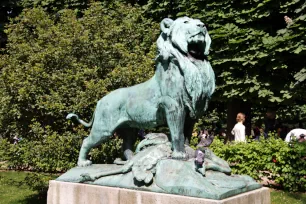
A handful of statues in the Jardin du Luxembourg depict animals. There are several lion statues in the park, the largest of them is called the Nubian lion and his prey ![]() . A nubian lion is the largest of the lion species. The bronze sculpture was created in 1870 by Auguste Cain, a French sculptor specialized in animals.
. A nubian lion is the largest of the lion species. The bronze sculpture was created in 1870 by Auguste Cain, a French sculptor specialized in animals.
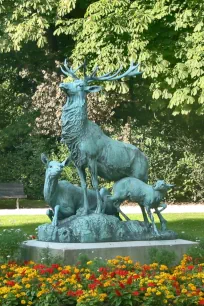
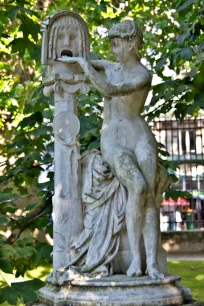
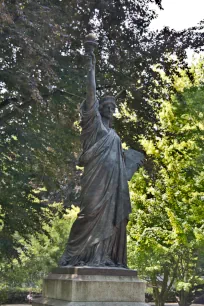
One of the best known monuments in the Jardin du Luxembourg is a large sculpture group on the south lawn of the park that shows a stag, doe and fawn. It is officially known as the Harde de cerfs écoutant le rapproché ![]() , which can be freely translated as a deer herd listening to the approaching hunters. The bronze work was created in 1886 by Arthur le Duc, another French sculptor.
, which can be freely translated as a deer herd listening to the approaching hunters. The bronze work was created in 1886 by Arthur le Duc, another French sculptor.
More statues and monuments
There are many other interesting statues and monuments in the Jardin du Luxembourg. One of the most interesting is The mask seller ![]() , a monument created in 1883 by the French sculptor Zacharie Astruc that was placed in this park three years later. There are eight masks around the base of the monument. Each of them shows the face of a famous French personality from the nineteenth century. With his left hand, the mask seller holds up a mask of the famous French writer Victor Hugo. Originally he held three more masks in his right hand, but those have disappeared.
, a monument created in 1883 by the French sculptor Zacharie Astruc that was placed in this park three years later. There are eight masks around the base of the monument. Each of them shows the face of a famous French personality from the nineteenth century. With his left hand, the mask seller holds up a mask of the famous French writer Victor Hugo. Originally he held three more masks in his right hand, but those have disappeared.
In the southwest area of the park is a marble sculpture group known as Joie de la famille ![]() (the joy of family), also known as Bonheur (happiness). It was created in 1889 by Horace Daillion and depicts a blissful couple holding a small child, with a pet looking up towards them.
(the joy of family), also known as Bonheur (happiness). It was created in 1889 by Horace Daillion and depicts a blissful couple holding a small child, with a pet looking up towards them.
One of the very few modern sculptures in the Jardin du Luxembourg is the Monument aux étudiants résistants ![]() , a monument to the students who died in World War II as part of the resistance. The bronze sculpture was created by Gaston Watkin and was unveiled here in 1956.
, a monument to the students who died in World War II as part of the resistance. The bronze sculpture was created by Gaston Watkin and was unveiled here in 1956.
And there’s also a bit of Rome in the Jardin du Luxembourg thanks to the Bocca della Verità monument ![]() , which depicts a woman who puts her hand in the Mouth of Truth. The marble statue was created in 1871 by the French Sculptor Jules Blanchard and is a reference to the Roman legend where people put their hand in the mouth of a stone face to prove they are speaking the truth. According to the legend, the mouth will close if the person told a lie.
, which depicts a woman who puts her hand in the Mouth of Truth. The marble statue was created in 1871 by the French Sculptor Jules Blanchard and is a reference to the Roman legend where people put their hand in the mouth of a stone face to prove they are speaking the truth. According to the legend, the mouth will close if the person told a lie.
You might be surprised to see La Liberté ![]() (Liberty), a 2.9-meter version of the Statue of Liberty here. The statue was created by Auguste Bartholdi himself and is a bronze version of the original plaster model that he used for the full-size version that was gifted to the United States and which he built in his workshop in Paris near Parc Monceau. The statue you see today is a replica; in 2012 the original moved to the Musée d’Orsay to protect it from the elements.
(Liberty), a 2.9-meter version of the Statue of Liberty here. The statue was created by Auguste Bartholdi himself and is a bronze version of the original plaster model that he used for the full-size version that was gifted to the United States and which he built in his workshop in Paris near Parc Monceau. The statue you see today is a replica; in 2012 the original moved to the Musée d’Orsay to protect it from the elements.
Map of Jardin du Luxembourg
